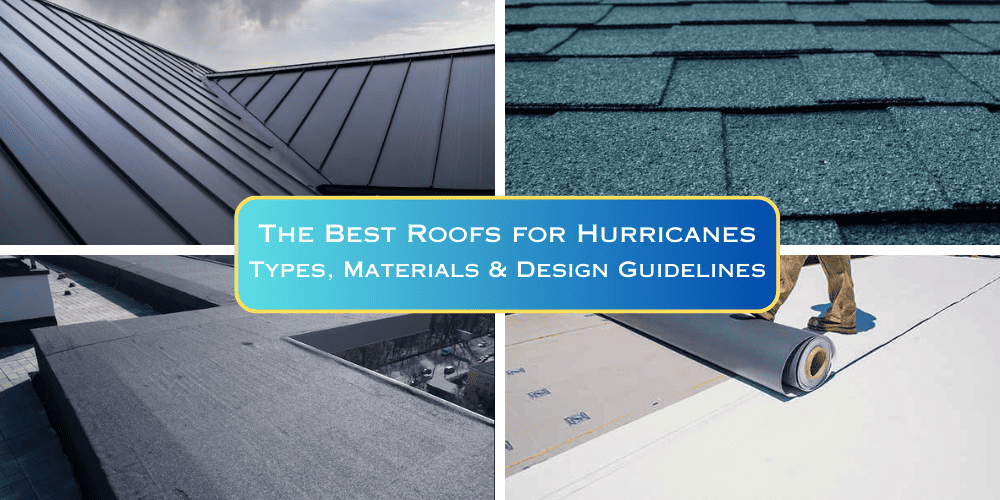
The Fight Against Nature’s Fury
You already know the drill if you’re a homeowner living in a hurricane-prone area. Every summer is an exercise in preparing your property for the inevitable storms you’ll face in the fall. And your roof, which shields you from wind and rain, will often be the first thing impacted by high winds and heavy rain.
If you have roof damages or want to prepare for inclement weather, it pays to seek out professional roof repair and replacement services, like those provided by Statewide Roofing Specialist.
And to get the most out of those roof repairs or replacement, you’ll want to have a solid grasp on different available roofing types, materials, and designs. In this blog, we’ll help you become familiar with the best roofing options for hurricane season, including design guidelines to keep you protected in any weather.
Understanding Your Roofing Needs
When selecting a roof, you’ll want to ensure that it’s up to handling the worst aspects of your environment. High winds, rain, and debris are common during hurricane season, and your roof will need to withstand these conditions.
Check your home’s location and the climate of your region. A strong and durable roof is a must, but it should also fit with your house’s and neighborhood’s aesthetics. Remember, a good roof isn’t just about protection; it’s about enhancing your home’s value and curb appeal too.
Let’s Talk About Roofing Types
1. Metal Roofs
A very popular roofing style due to its longevity, durability, and energy efficiency. These roofs are designed to withstand extreme weather conditions, are fire-resistant, and reflect sunlight, reducing energy costs. Most metal roofs are also treated with a special coating that helps prevent rust and corrosion. However, there are two primary types, first one is standing seam coating, and the second one is metal tile or shingles.
2. Shingle Roof
The most common type of residential roofing in America. These shingles are built from a base (either organic felt or a fiberglass mat) coated with asphalt and then covered with granules that provide color and reflect sunlight. These roofs are available in a variety of colors and protect against moisture and harsh weather conditions. They offer a premium look and added durability. Shingles are categorized into two types: three-tab shingles and asphalt shingles for roofs.
3. EPDM Roof (Ethylene Propylene Diene Monomer)
A type of rubber roofing membrane widely used on low-slope buildings. It’s a highly durable synthetic rubber roofing membrane (ethylene and propylene). They are flexible and lightweight, put less of a burden on the rest of your structure, and are known for standing up well to high temperatures.
4. TPO Roof (Thermoplastic Olefin)
A TPO roof is a single-ply roofing membrane that covers the roof’s surface. Available in several color options and manufactured in widths of 10, 12, and 20 feet wide, TPO roofs are known for their strength, durability, and flexibility. They’re resistant to ultraviolet rays and chemical exposure, making them extremely effective in resisting the harmful effects of the sun and common industrial pollutants.
The Best Materials for Hurricane-Resistant Roofs
When handling hurricane-level winds, choosing the right roofing material is just as important as picking the correct roof type. Here are our top three recommendations:
1. Metal Roofing
Extremely durable and resistant to high winds, metal roofs are a great choice for hurricane-prone areas. They offer excellent protection, have a long lifespan, and require little maintenance.
2. Concrete or Clay Tiles
These are heavier roofing materials that can be advantageous in high-wind situations. They offer superior durability and can resist wind speeds that most other roofing materials can’t.
3. Asphalt Shingles
High-quality, wind-rated shingles can effectively protect against high winds and driving rain. They are less expensive than metal or tile, making them cost-effective shingles for hurricane-prone areas.
Design is Crucial for a Hurricane-Resistant Roof
The design and structure of your roof play an equally important role in protecting your home. Here are some tips to keep in mind:
- Secure Fastenings: Roofs should be securely fastened to the house frame to avoid the effects of wind uplift.
- Sealants and Underlays: Using a strong adhesive roof sealant can help prevent water penetration. A high-quality underlay is also needed to prevent water damage.
- Adequate Roof Overhangs: Roof overhangs can be vulnerable to wind uplift. Keep them to a minimum to reduce the risk.
- Roofing Edges: Secure the roofing edges well, as they are often the first parts to peel off during high winds.
Be Hurricane Ready with Statewide Roofing Specialist
Statewide Roofing Specialist knows the trouble hurricanes bring for homeowners. And we want to ensure that your home is as protected as possible when storm season arrives.
Choosing the best roof for hurricanes is important to keep your property in top condition. With the right knowledge about roof types, materials, and design elements, you can make informed decisions that protect your home and enhance its beauty and value. When it comes to roofing decisions, count on Statewide Roofing Specialist – be it installation of a new roof, repair, or renovation. Our experienced roofers work diligently to provide you with the highest quality materials and dedicated customer service. Give us a call at (336) 480-1824 and let us help you weather the storm worry-free.
